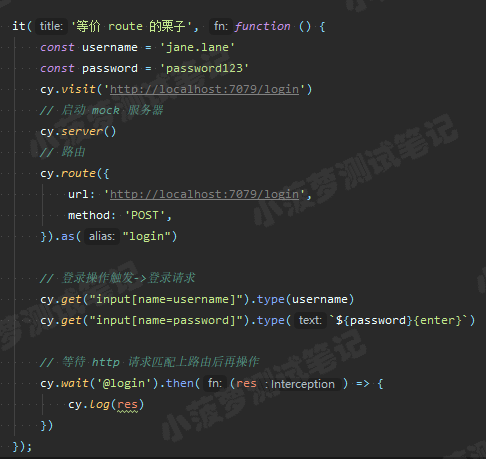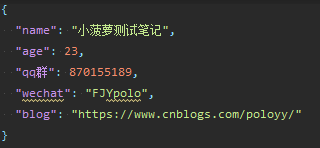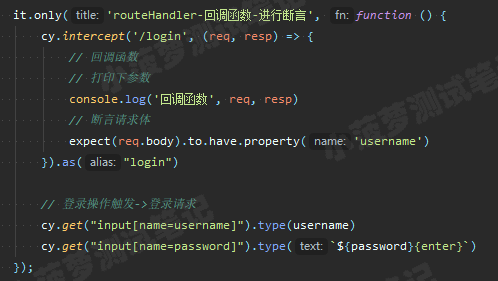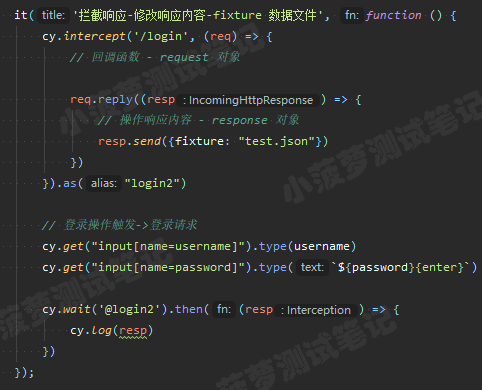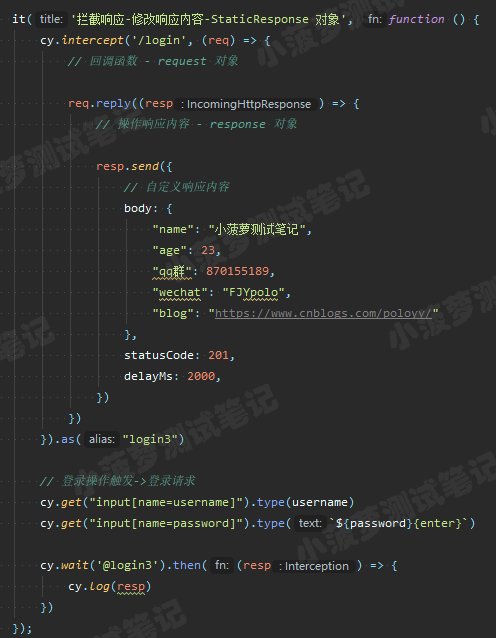作用
注意
包含以下功能
- 对任何类型的 HTTP 请求进行 stub 或 spy
- 在 HTTP 请求发送到目标服务器前,可以修改 HTTP 请求 body、headers、URL(类似抓包工具对请求进行打断点然后修改)
- 动态或静态地对 HTTP 请求的响应进行 stub
- 接收 HTTP 响应后可对 HTTP 响应 body、headers、status、code 进行修改(类似抓包工具对响应进行打断点然后修改)
- 在所有阶段都可以完全访问所有 HTTP 请求
相较于 cy.route() 的不同
cy.route() 命令详解:https://www.cnblogs.com/poloyy/p/13852941.html
- 可以拦截所有类型的网络请求,包括 Fetch API,页面加载,XMLHttpRequest,资源加载等
- 不需要在使用前调用 cy.server() ,实际上 cy.server() 根本不影响 cy.intercept()
- 默认情况下没有将请求方法设置为 GET
语法格式
cy.intercept(url, routeHandler?)cy.intercept(method, url, routeHandler?)cy.intercept(routeMatcher, routeHandler?)
url
要匹配的请求 URL ,可以是字符串也可以是正则表达式
cy.intercept('http://example.com/widgets')cy.intercept('http://example.com/widgets', { fixture: 'widgets.json' })
method
请求方法
cy.intercept('POST', 'http://example.com/widgets', {statusCode: 200,body: 'it worked!'})
routeMatcher
- 它是一个对象
- 用于匹配此路由将处理哪些传入的 HTTP 请求
- 所有对象属性都是可选的,不是必填的
- 设置的所有属性必须与路由匹配才能处理请求
- 如果将字符串传递给任何属性,则将使用 minimatch 将与请求进行全局匹配
它有以下属性
{/*** 与 HTTP Basic身份验证中使用的用户名和密码匹配*/auth?: { username: string | RegExp, password: string | RegExp }/*** 与请求上的 HTTP Headers 匹配*/headers?: {[name: string]: string | RegExp}/*** 与请求上的 hostname 匹配*/hostname?: string | RegExp/*** If 'true', 只有 https 的请求会被匹配* If 'false', 只有 http 的请求会被匹配*/https?: boolean/*** 与请求上的 method 请求方法匹配* 默认 '*', 匹配全部类型的 method*/method?: string | RegExp/*** 主机名后的路径, 包括了 ? 后面的查询参数* www.baidu.com/s?wd=2*/path?: string | RegExp/*** 和 path 一样, 不过不管 ? 后面的查询参数* www.baidu.com/s*/pathname?: string | RegExp/*** 与指定的端口匹配, 或者传递多个端口组成的数组, 其中一个匹配上就行了*/port?: number | number[]/*** 与请求路径 ? 后面跟的查询参数匹配上* wd=2*/query?: {[key: string]: string | RegExp}/*** 完整的请求 url* http://www.baidu.com/s?wd=2*/url?: string | RegExp}
routeHandler
- routeHandler 定义了如果请求和 routeMatcher 匹配将对请求进行的指定的处理
- 可接受的数据类型:string、object、Function、StaticResponse
StaticResponse
- 相当于一个自定义响应体对象
- 可以自定义 Response headers、HTTP 状态码、Response body 等
- 详细栗子将在后面展开讲解
StaticResponse 对象的属性
{/*** 将 fixture 文件作为响应主体, 以 cypress/fixtures 为根目录*/fixture?: string/*** 将字符串或 JSON 对象作为响应主体*/body?: string | object | object[]/*** 响应 headers* @default {}*/headers?: { [key: string]: string }/*** 响应状态码* @default 200*/statusCode?: number/*** 如果 true, Cypress 将破坏网络连接, 并且不发送任何响应* 主要用于模拟无法访问的服务器* 请勿与其他选项结合使用*/forceNetworkError?: boolean/*** 发送响应前要延迟的毫秒数*/delayMs?: number/*** 以多少 kbps 发送响应体*/throttleKbps?: number}
string
- 如果传递一个字符串,这个值相当于响应 body 的值
- 等价于 StaticResponse 对象 { body: “foo” }
object
- 如果传递了没有 StaticResponse 密钥的对象,则它将作为 JSON 响应 Body 发送
- 例如, {foo:’bar’} 等价于 StaticResponse 对象 {body:{foo:’bar’}}
function
- 如果传递了一个回调函数,当一个请求匹配上了该路由将会自动调用这个函数
- 函数第一个参数是请求对象
- 在回调函数内部,可以修改外发请求、发送响应、访问实际响应
- 详细栗子将在后面展开讲解
命令返回结果
- 返回 null
- 可以链接 as() 进行别名,但不可链接其他命令
- 可以使用 cy.wait() 等待 cy.intercept() 路由匹配上请求,这将会产生一个对象,包含匹配上的请求/响应相关信息
实际栗子的前置准备
Cypress 官方项目的下载地址:https://github.com/cypress-io/cypress-example-kitchensink
下载好后进入下图项目文件夹
启动项目
通过 URL 路由匹配请求的栗子
测试代码
等价于 route() 的测试代码
运行结果
Console 查看 cy.wait() 返回的对象

最重要的当然是 request 和 response 两个属性
通过 RouteMatcher 路由匹配请求的栗子
测试代码
运行结果
Console 查看 cy.wait() 返回的对象
另一种断言方式
// 断言匹配此路由的请求接收到包含【username】的请求 bodycy.wait('@login3').its('request.body').should('have.property', 'username')// 断言匹配此路由的请求接收到 HTTP 状态码为 500cy.wait('@login3').its('response.statusCode').should('eq', 200)// 断言匹配此路由的请求接收到包含【redirect】的请求 bodycy.wait('@login3').its('response.body').should('have.property', 'redirect')
不过这样的话只能每次写一条不能同时三条都写,所以还是建议像代码图一样,先 .then() 再进行断言
自定义不同类型的响应体的各种栗子
自定义一个纯字符串的响应体
测试代码
运行结果
接口响应
自定义一个 JSON 的响应体
测试代码

会从cypress安装目录/fixtures 下读取对应的数据文件,它会变成响应 body 的数据
test.json 数据文件
运行结果
接口响应
自定义一个 StaticResponse 的响应体
测试代码

自定义了响应body、statusCode,还有返回响应的延时时间
运行结果

延时生效了

body 和 statusCode 变成自定义的数据了
拦截请求的栗子
前置操作
beforeEach(() => {cy.visit('http://localhost:7079/login')})
断言请求的栗子
测试代码
运行结果
Console 查看打印结果
重点
回调函数内不能包含 cy.**() 的命令,如果包含会报错
简单来说就是
cy.type() 命令执行完后会返回一个 promise 对象,同时又会调用回调函数,而回调函数内又调用了 cy.get() 返回了一个 promise 对象,Cypress 会将这种情况当做测试失败处理
将请求传递给下一个路由处理程序
前言
测试代码
运行结果

一个登录请求匹配成功了两个路由,且回调函数会按匹配的顺序执行
总结
回调函数的参数就是一个请求对象,它其实可以调用以下方法
{/*** 销毁该请求并返回网络错误的响应*/destroy(): void/*** 控制请求的响应* 如果传入的是一个函数, 则它是回调函数, 当响应时会调用* 如果传入的是一个 StaticResponse 对象, 将不会发出请求, 而是直接将这个对象当做响应返回*/reply(interceptor?: StaticResponse | HttpResponseInterceptor): void/*** 使用 response body(必填) 和 response header(可选) 响应请求*/reply(body: string | object, headers?: { [key: string]: string }): void/*** 使用 HTTP 状态码(必填)、 response body(可选)、response header(可选) 响应请求*/reply(status: number, body?: string | object, headers?: { [key: string]: string }): void/*** 重定向到新的 location 来响应请求,* @param statusCode 用来重定向的 HTTP 状态代码, Default: 302*/redirect(location: string, statusCode?: number): void}
拦截响应的栗子
req.reply() 函数详解
前言
可以使用 req.reply() 函数来动态控制对请求的响应
使用讲解
cy.intercept('/login', (req) => {// functions on 'req' can be used to dynamically respond to a request here// 将请求发送到目标服务器req.reply()// 将这个 JSON 对象响应请求req.reply({plan: 'starter'})// 将请求发送到目标服务器, 并且拦截服务器返回的实际响应, 然后进行后续操作(类似抓包工具对响应打断点)req.reply((res) => {// res 就是实际的响应对象})})
.reply() 直接修改响应的栗子
测试代码
接口响应内容
拦截响应的小栗子
测试代码
运行结果
Console 查看打印结果
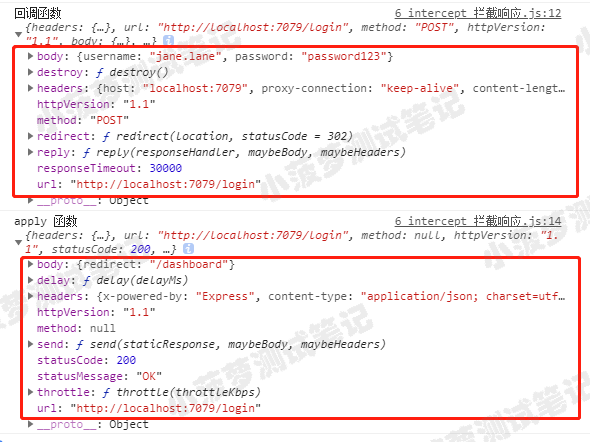
一个是 request 对象,一个是 response 对象
自定义响应内容
前言
- 可以使用 resp.send() 函数动态控制传入的响应
- 另外,当响应发送到浏览器时,对 resp 的任何修改都将保留
- 如果尚未调用 resp.send() ,则它会在 req.reply() 回调函数完成后隐式调用
使用讲解
cy.intercept('/notification', (req) => {req.reply((resp) => {// Success 将作为 response body 返回到浏览器resp.send('Success')// 将 success.json 里面的数据作为 response body 返回到浏览器resp.send({fixture: 'success.json'})// 将响应延迟 1000msresp.delay(1000)// 将响应限制为 64kbpsresp.throttle(64)})})
传递字符串作为响应内容
测试代码
接口响应内容
传递 JSON 对象作为响应内容
测试代码
接口响应内容
传递 StaticResponse 对象作为响应内容
测试代码
接口响应内容
resp 可调用的函数总结
{/*** 可以自定义 response statusCode、response body、response header* 也可以直接传 StaticResponse 对象*/send(status: number, body?: string | number | object, headers?: { [key: string]: string }): voidsend(body: string | object, headers?: { [key: string]: string }): voidsend(staticResponse: StaticResponse): void/*** 继续返回响应*/send(): void/*** 等待 delayMs 毫秒,然后再将响应发送给客户端*/delay: (delayMs: number) => IncomingHttpResponse/*** 以多少 kbps 的速度发送响应*/throttle: (throttleKbps: number) => IncomingHttpResponse}






